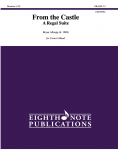Fantasia Nova is a suite comprising two concert marches and a slow, middle movement that derives its themes from both marches.
Ragtime (composed in early September, 1978) is a "new from old" sort of piece: Although its tunefulness and harmonies have an old-fashioned character, its structure, development, and orchestration are unusual for a march.
In the "chorale" section (measures 111 - 148) the band director must be very careful in balancing, for each of the elements must come through. More important is that the audience be "brought up" by this section -- filled with a joyous exaltation; great attention must be paid to sonority and the band must play earnestly.
Ragtime stands on its own and may be performed separately.
Dreams (composed in late September, 1978) is the traditional march of the two. It is very closely modeled (in structure only) to Sousa's Stars and Stripes Forever. It even includes a tricky piccolo solo, although the accompaniment has a chorale texture, almost like a school alma mater. This march as a patriotic, inspirational sound, because it was composed for the town of Irondequoit, New York -- for a "Town March" contest held by the town's community concert band. It did not, so far as I know, become the town's march; one can hear the name, Irondequoit, throughout the Trio, for every turn of the melody (in fact, each group of four notes) fits the accent pattern (Ih-RON-dih-kwoit) of the town's name.
Parade stands on its own as a complete work and may be performed separately.
Because the cornet, horn (tenor saxophone), and piccolo are so prominent, they may be considered to be soloists.
Percussion Instrumentation
Five players are required, as follows: Iº -- Timpani, Triangle (small), Triangle (large), Cowbells (optional).
IIº -- Glockenspiel, Xylophone, Tubular Bells, Cymbal (suspended), Woodblock, Triangle (small).
IIIº -- Snare Drum, Tambourine.
IVº -- Cymbals (one pair of hand cymbals), Lion's Roar.
Vº -- Bass Drum. [IVº and Vº can be performed by a single player, if necessary.
Optional extra players: Tubular Bells (in the first movement), Vibraphone (in the first movement). The Tubular Bells part takes preference. Also, Tambourine (in the first movement -- instead of player IIIº). In the last movement: Snare and Field Drums ad lib. [Player Iº has a separate part; players IIº - Vº have their parts combined on the Percussion part.]
Acknowledgment
I should like to express my gratitude to Raymond S. Becker, Jr., the conductor of the Marine Band of Allentown, Pennsylvania, who in 1978 read through Parade (in an early version) so I could hear what it sounded like; to my parents, Dorothy and Harry Margolis, for their support and encouragement; and to Donald S. George, conductor of the University of Wisconsin-Eau Claire Symphony Band, who conducted the first performance of Fantasia Nova on December 2nd, 1979 at Gantner Concert Hall, the University of Wisconsin - Eau Claire.
Bob Margolis



